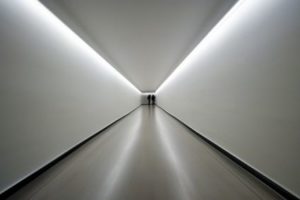Sprinkler Advantages for Dead End Corridors
What is a dead-end corridor? The International Building Code (IBC) defines a corridor as, “an enclosed exit access component that defines and provides a path of egress travel.” For the purpose of this blog, a corridor is typically a space where the building occupant has limited choices as to paths or directions of travel. The available path is restricted and is usually bordered by occupied-use spaces. Consequently, it is potentially exposed to fires that might occur in those enclosed spaces. To further add to this dilemma, a dead-end corridor may exist.
Imagine trying to escape a forest fire in your vehicle and the visibility is extremely limited. In these moments, you want to make certain you are going the right way. Imagine second guessing every turn you have made only to find that the road you are on dead ends and the only place to is back from where you came. The last thing anyone wants is for someone to go down a path they think could lead to an exit, only to realize they thought wrong, and they have to backtrack through the potential danger from which they fled. It literally could be a life or death situation.

Image Courtesy of www.beaver.ab.ca
The egress delay may only be seconds for a healthy adult in an environment that allows him or her to walk upright. The delay becomes much greater when given a smoke-filled corridor and the same healthy adult on their hands and knees. A normal adult traveling at 250 feet per minute would traverse the 40
foot round trip in a 20-foot dead end corridor in 10 seconds, or 24 seconds for a round trip in a 50 foot
dead end corridor. It will take substantially longer on their hands and knees to traverse the same
distances. Assuming 100 feet of travel per minute, these times become 24 seconds and 60 seconds, respectively.
Imagine getting to the end of long dead-end corridor and finding no exit. Now you must turn around and traverse back from where you previously came. Adding these seconds to the egress times to traverse the allowable travel distances, could greatly increase the overall egress times and increase the opportunity for a fatality substantially.
The International Building Code (IBC) section 1020.4 tackles the requirements for the dead-end corridors. It states that when there is more than one exit required from a building, no dead ends in corridors can exceed 20’. Although the code states 20’ is the max, you should remember that a person who reaches the end of a 20’ dead-end will travel an additional 20 feet, a total distance of 40 feet, to get back to where they had options to get to an exit. These are valuable seconds that one may need to exit safely from a building. And at the end of the day and above all else, even above a beautifully designed building, safety is the number one priority, even above a beautifully designed building.

Image of Courtesy of EV Studio
However, when an automatic fire sprinkler system is installed, in most occupancies, the length of a dead corridor can be extended to 50 feet. The fire sprinkler system will increase the available safe time to evacuate, by providing an earlier alarm and slowing the fire growth and the products of combustion. This valuable time could make the difference between someone surviving or becoming a fatality.
Installing an automatic fire sprinkler system not only provides additional time to traverse the egress paths present it also provides more flexibility for designers as they design these spaces. The additional permittable travel distance can save valuable time and construction costs considerations.
Using these sprinkler tradeoffs is a major advantage in the design phase. These tradeoffs can provide a major cost savings in the overall construction project. Especially when you compile them with many additional sprinkler tradeoffs which can be found in the, “NFSA Sprinkler Guide: 2018 International Building Code Edition.” We will continue discussing these tradeoffs in detail in future blogs.
